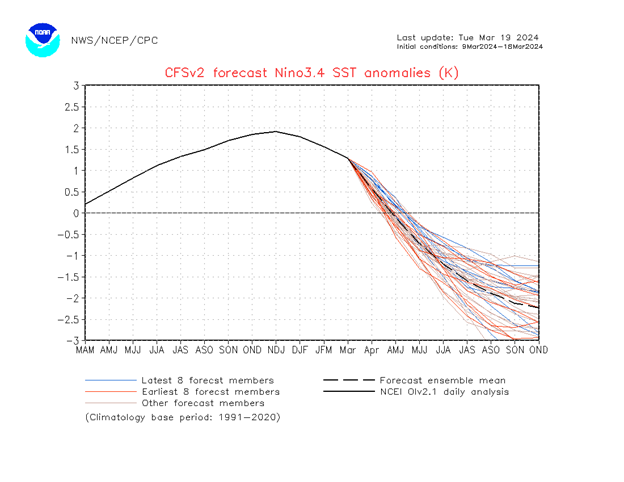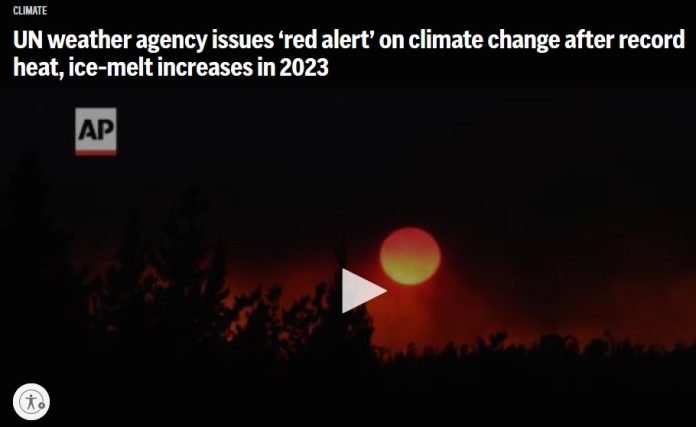The Associated Press (AP) ran a story claiming that a “red alert” was issued by The United Nations (UN) weather agency, the World Meteorological Organization (WMO), which claimed that global temperature in 2023 set new records due to human caused climate change, and expectations that new record high temperatures would be set in 2024. The story is misleading at the very least. It is based on a false premise, because the UN didn’t reference historical nor current real-world data before issuing the report that the AP story touted.
On March 19th, the AP carried a story, titled UN weather agency issues ‘red alert’ on climate change after record heat, ice-melt increases in 2023. The story begins with this:
The U.N. weather agency is sounding a “red alert” about global warming, citing record-smashing increases last year in greenhouse gases, land and water temperatures, and melting of glaciers and sea ice, and is warning that the world’s efforts to reverse the trend have been inadequate.
The World Meteorological Organization said there is a “high probability” that 2024 will be another record-hot year.
The AP’s story is based upon the “State of the Climate” report issued by the UN, which states:
The WMO report confirmed that 2023 was the warmest year on record, with the global average near-surface temperature at 1.45 °Celsius (with a margin of uncertainty of ± 0.12 °C) above the pre-industrial baseline. It was the warmest ten-year period on record.
“Sirens are blaring across all major indicators… Some records aren’t just chart-topping, they’re chart-busting. And changes are speeding-up.” said United Nations Secretary-General António Guterres.
…
The shift from La Niña to El Niño conditions in the middle of 2023 contributed to the rapid rise in temperature from 2022 to 2023.
That AP’s claim of a high probability of a record warm year is already headed towards low probability territory even as the statement was issued. Had the WMO acted like meteorologists rather than climate alarm advocates, they would have noticed an inconvenient fact that never made their report: the El Niño which “contributed to the rapid rise in temperature from 2022 to 2023,” is on the way to the cooler La Niña phase already. This is shown in the data informing the Figure 1 below from the National Oceanic and Atmospheric Administration:

In Figure 1 above, the solid black line is an indicator of the measured sea surface temperature (SST) anomalies in the Pacific Ocean. Notice that the peak occurred during the period of November 2023 through December and January of 2024. That was when the El Niño conditions in the Pacific Ocean were at their warmest. However, since then ocean temperatures have started to significantly decline and the forecast temperatures through October and November of 2024 are about 4.2° below the peak temperature during the El Niño event.
Between the measured decline in SST temperature already and the forecast into 2024 this suggests that the claim of “high probability that 2024 will be another record-hot year,” is almost certain to prove false.
The UN is conflating yearly weather patterns with long term climate change. The WMO itself defines climate as measured trends over a 30 year period, being an average of weather over 30 years. A single year of warm temperatures means nothing in the long-term scheme of things for climate change. El Niño Is a pattern of weather in the Pacific Ocean that has been going on for millennia which changes from year to year. As described in Climate at a Glance: El Niño and Global Warming,
According to NOAA: “El Niño is a naturally occurring climate pattern associated with warming of the ocean surface temperatures in the central and eastern tropical Pacific Ocean, which can significantly influence weather patterns, ocean conditions, and marine fisheries worldwide.”
In fact, records going as far back as 1876 show that many similarly sized El Niño events occurred, as seen in figure 2, below:

Given that we only have about 100 years of good temperature records for the globe and because the earth is billions of years old with naturally occurring events that we have no record of, it’s certainly likely that particularly warm years caused by El Nino conditions have gone unnoticed and unrecorded. Creating a “red alert” alarm over a single year of warm temperatures driven by El Niño, especially since indicators show the driver is now on the way down, is not only irrational, it’s an irresponsible red herring.
It certainly appears that 2024 will in fact be cooler than 2023. Given the WMO’s and the media’s past behavior, it’s highly unlikely that the AP will issue a retraction or even a story mentioning that the forecast made by the U.N. failed to materialize in late 2024.
This is just another shameful episode of the media regurgitating irresponsible climate alarm claims without bothering to check the facts.























Sorry, but we don’t have “100 years of good temperature records for the globe”. Even weather station data is hopelessly corrupted as demonstrated by the author of this article, Mr. Watts.
There were also no-to-few measuring stations on major landmasses, and those that did were few and far between. South America had two temperature stations at the turn of the 20th century.
It was only in the last 40 or so years that temperature-data recording began in earnest, and then largely taken over by satellites. Even the GHCN has been corrupted by alterations of its core data by homogenization and urban bias. And based on the size of the oceans, our temperature-bouy system (ARGO) covers about .04% of its entire surface. We do not have a robust or trustworthy temperature history. We do have a lot of wishful thinking.